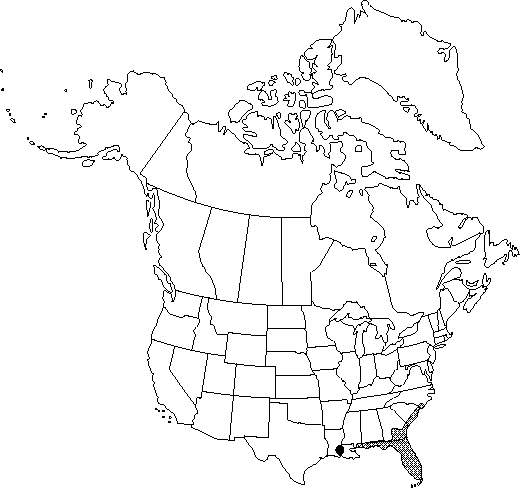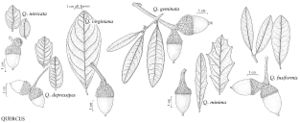Difference between revisions of "Quercus geminata"
Bull. Torrey Bot. Club 24: 438. 1897.
FNA>Volume Importer |
imported>Volume Importer |
||
| (7 intermediate revisions by 2 users not shown) | |||
| Line 9: | Line 9: | ||
|common_names=Sand live oak | |common_names=Sand live oak | ||
|special_status={{Treatment/ID/Special_status | |special_status={{Treatment/ID/Special_status | ||
| + | |code=W1 | ||
| + | |label= | ||
| + | }}{{Treatment/ID/Special_status | ||
|code=F | |code=F | ||
| − | |label= | + | |label=Illustrated |
| − | |||
| − | |||
| − | |||
}} | }} | ||
|basionyms= | |basionyms= | ||
|synonyms={{Treatment/ID/Synonym | |synonyms={{Treatment/ID/Synonym | ||
| − | |name= | + | |name=Quercus virginiana var. geminata |
|authority=(Small) Sargent | |authority=(Small) Sargent | ||
| + | |rank=variety | ||
}} | }} | ||
|hierarchy=Fagaceae;Quercus;Quercus sect. Quercus;Quercus geminata | |hierarchy=Fagaceae;Quercus;Quercus sect. Quercus;Quercus geminata | ||
| Line 27: | Line 28: | ||
}}<!-- | }}<!-- | ||
| − | --><span class="statement" id="st- | + | --><span class="statement" id="st-undefined" data-properties=""><b>Trees,</b> sometimes shrubs, subevergreen, trees to 25 m, shrubs sometimes rhizomatous (if spreading rhizomatously, without numerous straight, short, erect stems emerging from gound, or if so, mixed with other larger branches, infertile, and without dimorphic or asymmetric leaf form). <b>Bark</b> dark brown or black, scaly. <b>Twigs</b> yellowish, becoming light gray, 1.5-3 mm diam., tomentulose, glabrate in 2d year. <b>Buds</b> reddish or dark brown, globose or ovoid, 1-2.5(-3) mm; scale margins glabrous or puberulent. <b>Leaves</b>: petiole 3-10(-20) mm. <b>Leaf</b> blade narrowly lanceolate or elliptic, rarely orbiculate, convex-cupped, (10-)35-60(-120) × (7-)10-30(-45) mm, base narrowly cuneate, rarely truncate or rounded, margins strongly revolute, entire, secondary veins 8-10(-12) on each side, apex acute, sometimes obtuse; surfaces abaxially whitish or glaucous, densely covered with minute, appressed, fused-stellate hairs (visible under magnification), and with additional scattered, erect, felty or spreading hairs (sometimes deciduous), or light green and glabrate in shade leaves, adaxially dark or light green, glossy, glabrous or with minute, scattered, stellate hairs, secondary veins moderately to deeply impressed. <b>Acorns</b> 1-3, on peduncle 10-100 mm; cup hemispheric or deeply goblet-shaped, sometimes saucer-shaped, 8-15 mm deep × 5-15 mm wide, base often constricted, scales whitish or grayish, thickened basally, keeled, acute-attenuate, tomentulose, tips reddish, glabrous or puberulent; nut dark brown, ovoid, barrel-shaped, or acute, (13-)15-20(-25) × (8-)9-12(-15) mm, glabrous. <b>Cotyledons</b> connate.</span><!-- |
-->{{Treatment/Body | -->{{Treatment/Body | ||
| Line 34: | Line 35: | ||
|elevation=0-200 m | |elevation=0-200 m | ||
|distribution=Ala.;Fla.;Ga.;La.;Miss.;N.C.;S.C. | |distribution=Ala.;Fla.;Ga.;La.;Miss.;N.C.;S.C. | ||
| − | |discussion=<p>Quercus geminata occurs in Cuba as putative hybrids.</p><!-- | + | |discussion=<p><i>Quercus geminata</i> occurs in Cuba as putative hybrids.</p><!-- |
| − | --><p>Although some recent authors prefer to treat Quercus geminata as a variety of Q. virginiana, the two species are easily separable and rarely intergrade through most of the broad range in which they are sympatric. Apparently this is primarily because of habitat separation, but additionally Q. geminata flowers much later than Q. virginiana in any given geographic area. At the northern extreme of the range of Q. geminata, apparent intermediates with Q. virginiana are more common, possibly because flowering times of the two species overlap to a greater extent because of slower warming in the spring. Scattered intermediates also occur where the two species are sympatric on sands in coastal Mississippi.</p> | + | --><p>Although some recent authors prefer to treat <i>Quercus geminata</i> as a variety of <i>Q. virginiana</i>, the two species are easily separable and rarely intergrade through most of the broad range in which they are sympatric. Apparently this is primarily because of habitat separation, but additionally <i>Q. geminata</i> flowers much later than <i>Q. virginiana</i> in any given geographic area. At the northern extreme of the range of <i>Q. geminata</i>, apparent intermediates with <i>Q. virginiana</i> are more common, possibly because flowering times of the two species overlap to a greater extent because of slower warming in the spring. Scattered intermediates also occur where the two species are sympatric on sands in coastal Mississippi.</p> |
|tables= | |tables= | ||
|references= | |references= | ||
| Line 44: | Line 45: | ||
-->{{#Taxon: | -->{{#Taxon: | ||
name=Quercus geminata | name=Quercus geminata | ||
| − | |||
|authority=Small | |authority=Small | ||
|rank=species | |rank=species | ||
|parent rank=section | |parent rank=section | ||
| − | |synonyms= | + | |synonyms=Quercus virginiana var. geminata |
|basionyms= | |basionyms= | ||
|family=Fagaceae | |family=Fagaceae | ||
| Line 58: | Line 58: | ||
|publication title=Bull. Torrey Bot. Club | |publication title=Bull. Torrey Bot. Club | ||
|publication year=1897 | |publication year=1897 | ||
| − | |special status= | + | |special status=W1;Illustrated |
| − | |source xml=https:// | + | |source xml=https://bitbucket.org/aafc-mbb/fna-data-curation/src/2e0870ddd59836b60bcf96646a41e87ea5a5943a/coarse_grained_fna_xml/V3/V3_813.xml |
|genus=Quercus | |genus=Quercus | ||
|section=Quercus sect. Quercus | |section=Quercus sect. Quercus | ||
|species=Quercus geminata | |species=Quercus geminata | ||
| − | |||
| − | |||
| − | |||
| − | |||
| − | |||
| − | |||
| − | |||
| − | |||
| − | |||
| − | |||
| − | |||
| − | |||
| − | |||
| − | |||
| − | |||
| − | |||
| − | |||
| − | |||
| − | |||
| − | |||
| − | |||
| − | |||
| − | |||
| − | |||
| − | |||
| − | |||
| − | |||
| − | |||
| − | |||
| − | |||
| − | |||
| − | |||
| − | |||
| − | |||
| − | |||
| − | |||
| − | |||
| − | |||
| − | |||
| − | |||
| − | |||
| − | |||
| − | |||
| − | |||
| − | |||
| − | |||
| − | |||
| − | |||
| − | |||
| − | |||
| − | |||
| − | |||
}}<!-- | }}<!-- | ||
-->[[Category:Treatment]][[Category:Quercus sect. Quercus]] | -->[[Category:Treatment]][[Category:Quercus sect. Quercus]] | ||
Latest revision as of 22:51, 5 November 2020
Trees, sometimes shrubs, subevergreen, trees to 25 m, shrubs sometimes rhizomatous (if spreading rhizomatously, without numerous straight, short, erect stems emerging from gound, or if so, mixed with other larger branches, infertile, and without dimorphic or asymmetric leaf form). Bark dark brown or black, scaly. Twigs yellowish, becoming light gray, 1.5-3 mm diam., tomentulose, glabrate in 2d year. Buds reddish or dark brown, globose or ovoid, 1-2.5(-3) mm; scale margins glabrous or puberulent. Leaves: petiole 3-10(-20) mm. Leaf blade narrowly lanceolate or elliptic, rarely orbiculate, convex-cupped, (10-)35-60(-120) × (7-)10-30(-45) mm, base narrowly cuneate, rarely truncate or rounded, margins strongly revolute, entire, secondary veins 8-10(-12) on each side, apex acute, sometimes obtuse; surfaces abaxially whitish or glaucous, densely covered with minute, appressed, fused-stellate hairs (visible under magnification), and with additional scattered, erect, felty or spreading hairs (sometimes deciduous), or light green and glabrate in shade leaves, adaxially dark or light green, glossy, glabrous or with minute, scattered, stellate hairs, secondary veins moderately to deeply impressed. Acorns 1-3, on peduncle 10-100 mm; cup hemispheric or deeply goblet-shaped, sometimes saucer-shaped, 8-15 mm deep × 5-15 mm wide, base often constricted, scales whitish or grayish, thickened basally, keeled, acute-attenuate, tomentulose, tips reddish, glabrous or puberulent; nut dark brown, ovoid, barrel-shaped, or acute, (13-)15-20(-25) × (8-)9-12(-15) mm, glabrous. Cotyledons connate.
Phenology: Flowering spring.
Habitat: Coastal plain, open evergreen woodlands and scrublands on deep sandy soils, often with pines
Elevation: 0-200 m
Distribution

Ala., Fla., Ga., La., Miss., N.C., S.C.
Discussion
Quercus geminata occurs in Cuba as putative hybrids.
Although some recent authors prefer to treat Quercus geminata as a variety of Q. virginiana, the two species are easily separable and rarely intergrade through most of the broad range in which they are sympatric. Apparently this is primarily because of habitat separation, but additionally Q. geminata flowers much later than Q. virginiana in any given geographic area. At the northern extreme of the range of Q. geminata, apparent intermediates with Q. virginiana are more common, possibly because flowering times of the two species overlap to a greater extent because of slower warming in the spring. Scattered intermediates also occur where the two species are sympatric on sands in coastal Mississippi.
Selected References
None.
